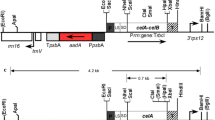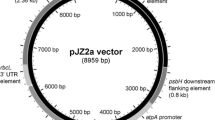Abstract
In chloroplasts, the light-modulated fructose-1,6-bisphosphatase catalyzes the formation of fructose 6-bisphosphate for the photosynthetic assimilation of CO2 and the biosynthesis of starch. We report here the construction of a plasmid for the production of chloroplast fructose-1,6-bisphosphatase in a bacterial system and the subsequent purification to homogeneity of the genetically engineered enzyme. To this end, a DNA sequence that coded for chloroplast fructose-1,6-bisphosphatase of rapeseed (Brassica napus) leaves was successively amplified by PCR, ligated into the Ndel/EcoRI restriction site of the expression vector pET22b, and introduced into Escherichia coli cells. When gene expression was induced by isopropyl-β-d-thiogalactopyranoside, supernatants of cell lysates were extremely active in the hydrolysis of fructose 1,6-bisphosphate. Partitioning bacterial soluble proteins by ammonium sulfate followed by anion exchange chromatography yielded 10 mg of homogeneous enzyme per 1 of culture. Congruent with a preparation devoid of contaminating proteins, the Edman degradation evinced an unique N-terminal amino acid sequence [A-V-A-A-D-A-T-A-E-T-K-P-]. Gel filtration experiments and sodium dodecyl sulfate-polyacrylamide gel electrophoresis indicated that the (recombinant) rapeseed chloroplast fructose-1,6-bisphosphatases was a tetramer [160 kDa] comprised of four identical subunits. Like other chloroplast fructose-1,6-bisphosphatases, the recombinant enzyme was inactive at 1 mM fructose 1,6-bisphosphate and 1 mM Mg2+ but became fully active after an incubation in the presence of either 10 mM dithiothreitol or 1 mM dithiothreitol and chloroplast thioredoxin. However, at variance with counterparts isolated from higher plant leaves, the low activity observed in absence of reductants was not greatly enhanced by high concentrations of fructose 1,6-bisphosphate (3 mM) and Mg2+ (10 mM). In the catalytic process, all chloroplast fructose-1,6-bisphosphatases had identical features; viz., the requirement of Mg2+ as cofactor and the inhibition by Ca2+. Thus, the procedure described here should prove useful for the structural and kinetic analysis of rapeseed chloroplast fructose-1,6-bisphosphatase in view that this enzyme was not isolated from leaves.
Similar content being viewed by others
Abbreviations
- DTT:
-
dithiothreitol
- PCR:
-
polymerase chain reaction
- EDTA:
-
(ethylenedinitrilo)tetraacetic
References
Ballicora MA and Wolosiuk RA (1994) Enhancement of the reductive activation of chloroplast fructose-1,6-bisphosphatase by modulators and protein perturbants. Eur J Biochem 222: 467–474
Buchanan BB (1991) Regulation of CO2 assimilation in oxygenic photosynthesis: The ferredoxin/thioredoxin system. Perspective on its discovery, present status, and future development. Arch Biochem Biophys 288: 1–9
Carrasco JL, Chueca A, Prado FE, Hermoso R, Lázaro JJ, Ramos JL, Sahrawy M and Lopez-Gorge J (1994) Cloning, structure and expression of a pea cDNA clone coding for a photosynthetic fructose-1,6-bisphosphatase with some features different from those of the leaf chloroplast enzyme. Planta 193: 494–501
Chen PS, Toribara TI and Warner H (1956) Microdetermination of phosphorus. Anal Chem 28: 1756–1758
Dilley RA and Vernon LP (1965) Ion and water transport processes related to light-dependent shrinkage of spinach chloroplasts. Arch Biochem Biophys 111: 365–375
Droux M, Crawford NA and Buchanan BB (1988) Mechanism of thioredoxin-linked activation of chloroplast fructose-1,6-bisphosphatase. Compt Rend Acad Sci 305: 335–342
Fonollá J, Hermoso R, Carrasco JL, Chueca A, Lázaro JJ, Prado F and Lopez-Gorgé J (1994) Antigenic relationships between chloroplast and cytosolic fructose-1,6-bisphosphatases. Plant Physiol 104: 381–386
Heber U, Takahama U, Neimanis S and Shimizu-Takahama M (1982) Transport as the basis of the Kok effect. Levels of some photosynthetic intermediates and activation of light-regulated enzymes during photosynthesis of chloroplasts and green leaf protoplasts. Biochim Biophys Acta 679: 287–299
Heldt HW, Werdan K, Milovancev M and Geller G (1973) Alkalization of the chloroplast stroma caused by light-dependent proton flux into the thylakoid space. Biochim Biophys Acta 314: 224–241
Hertig CM and Wolosiuk RA (1983) Studies on the hysteretic properties of chloroplast fructose-1,6-bisphosphatase. J Biol Chem 258: 984–989
Hirel Ph-H, Schmitter J-M, Dessen P, Fayat G and Blanquet S (1989) Extent of N-terminal methionine excision from Escherichia coli proteins is governed by the side-chain length of the penultimate amino acid. Proc Natl Acad Sci USA 86: 8274–8251
Huppe HC and Buchanan BB (1989) Activation of a chloroplast type of fructose-1,6-bisphosphatase from Chlamydomonas reinhardtii by light-mediated agents. Z Naturforsch 44 (c): 487–494
Kelly GJ, Zimmerman G and Latzko E (1982) Fructose bisphosphatase from spinach chloroplast and cytoplasm. Meth Enzymol 90: 371–378
Laemmli UK (1970) Cleavage of structural proteins during the assembly of the head of bacteriophage T4. Nature 227: 680–685
Leegood RC and Walker DA (1980) Modulation of fructose bisphosphatase activity in intact chloroplasts. FEBS Lett 116: 21–24
Lilley RMcC, Chon CJC, Mosbach A and Heldt HW (1977) The distribution of metabolites between spinach chloroplasts and medium during photosynthesis in vitro. Biochim Biophys Acta 460: 259–272
Marcus F and Harrsch PB (1990) Amino acid sequence of spinach chloroplast fructose-1,6-bisphosphatase. Arch Biochem Biophys 279: 151–157
Rodriguez-Andres A, Lázaro JJ, Chueca A, Hermoso R and Lopez-Gorge J (1990) Effect of alcohols on the association of photosynthetic fructose-1,6-bisphosphatase to thylakoid membranes. Physiol Pl 78: 409–413
Rodriguez-Suarez RJ and Wolosiuk RA (1993) Sequence of a cDNA encoding chloroplast fructose-1,6-bisphosphatase from rapeseed. Plant Physiol 103: 1453–1454
Sambrook J, Fritsch E and Maniatis T (1989) Molecular Cloning. A Laboratory Manual. 2nd ed. Cold Spring Laboratory Press, New York
Schürmann P and Wolosiuk RA (1978) Studies on the regulatory properties of chloroplast fructose-1,6-bisphosphatase. Biochim Biophys Acta 522: 130–138
Stein M (1987) Estudios de regulación enzimática en sistemas fotosintéticos. PhD Thesis, University of Buenos Aires
Stein M and Wolosiuk RA (1987) The effect of chaotropic anions on the activation and the activity of spinach chloroplast fructose-1,6-bisphosphatase. J Biol Chem 262: 16171–16179
Stein M, Lázaro JJ and Wolosiuk RA (1989) Concerted action of cosolvents, chaotropic anions and thioredoxin on chloroplast fructose-1,6-bisphosphatase. Reactivity to iodoacetamide. Eur J Biochem 185: 425–431
Stitt M and Quick WP (1989) Photosynthetic carbon partitioning: its regulation and possibilities for manipulation. Physiol Plant 77: 633–641
Wolosiuk RA, Crawford NA, Yee BC and Buchanan BB (1979) Isolation of three thioredoxins from spinach leaves. J Biol Chem 254: 1627–1632
Wolosiuk RA, Ballicora MA and Hagelin K (1993) The reductive pentose phosphate cycle for photosynthetic CO2 assimilation: enzyme modulation. FASEB J 7: 622–637
Author information
Authors and Affiliations
Rights and permissions
About this article
Cite this article
Rodriguez-Suarez, R.J., Wolosiuk, R.A. High level expression in Escherichia coli, purification and properties of chloroplast fructose-1,6-bisphosphatase from rapeseed (Brassica napus) leaves. Photosynth Res 46, 313–322 (1995). https://doi.org/10.1007/BF00020446
Received:
Accepted:
Issue Date:
DOI: https://doi.org/10.1007/BF00020446




